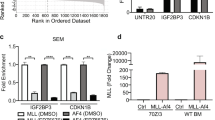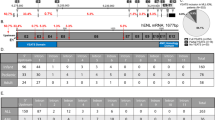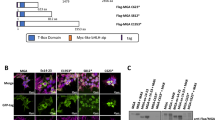Abstract
The gene MLL (encoding the protein mixed-lineage leukemia) is the target of chromosomal translocations that cause leukemias with poor prognosis. All leukemogenic MLL fusion proteins retain the CXXC domain, which binds to nonmethylated CpG DNA sites. We present the solution structure of the MLL CXXC domain in complex with DNA, showing how the CXXC domain distinguishes nonmethylated from methylated CpG DNA. On the basis of the structure, we generated point mutations that disrupt DNA binding. Introduction of these mutations into the MLL-AF9 fusion protein resulted in increased DNA methylation of specific CpG nucleotides in Hoxa9, increased H3K9 methylation, decreased expression of Hoxa9-locus transcripts, loss of immortalization potential, and inability to induce leukemia in mice. These results establish that DNA binding by the CXXC domain and protection against DNA methylation is essential for MLL fusion leukemia. They also provide support for viewing this interaction as a potential target for therapeutic intervention.
This is a preview of subscription content, access via your institution
Access options
Subscribe to this journal
Receive 12 print issues and online access
$189.00 per year
only $15.75 per issue
Buy this article
- Purchase on Springer Link
- Instant access to full article PDF
Prices may be subject to local taxes which are calculated during checkout






Similar content being viewed by others
Accession codes
References
Tkachuk, D.C., Kohler, S. & Cleary, M.L. Involvement of a homolog of Drosophila trithorax by 11q23 chromosomal translocations in acute leukemias. Cell 71, 691–700 (1992).
Sedkov, Y., Tillib, S., Mizrokhi, L. & Mazo, A. The bithorax complex is regulated by trithorax earlier during Drosophila embryogenesis than is the Antennapedia complex, correlating with a bithorax-like expression pattern of distinct early trithorax transcripts. Development 120, 1907–1917 (1994).
Yu, B.D., Hess, J.L., Horning, S.E., Brown, G.A. & Korsmeyer, S.J. Altered Hox expression and segmental identity in Mll-mutant mice. Nature 378, 505–508 (1995).
Muller, J., Gaunt, S. & Lawrence, P.A. Function of the Polycomb protein is conserved in mice and flies. Development 121, 2847–2852 (1995).
Orlando, V., Jane, E.P., Chinwalla, V., Harte, P.J. & Paro, R. Binding of trithorax and Polycomb proteins to the bithorax complex: dynamic changes during early Drosophila embryogenesis. EMBO J. 17, 5141–5150 (1998).
Guenther, M.G. et al. Global and Hox-specific roles for the MLL1 methyltransferase. Proc. Natl. Acad. Sci. USA 102, 8603–8608 (2005).
Rice, K.L. & Licht, J.D. HOX deregulation in acute myeloid leukemia. J. Clin. Invest. 117, 865–868 (2007).
Yu, B.D., Hanson, R.D., Hess, J.L., Horning, S.E. & Korsmeyer, S.J. MLL, a mammalian trithorax-group gene, functions as a transcriptional maintenance factor in morphogenesis. Proc. Natl. Acad. Sci. USA 95, 10632–10636 (1998).
Popovic, R. & Zeleznik-Le, N.J. MLL: how complex does it get? J. Cell. Biochem. 95, 234–242 (2005).
Sorensen, P.H. et al. Molecular rearrangements of the MLL gene are present in most cases of infant acute myeloid leukemia and are strongly correlated with monocytic or myelomonocytic phenotypes. J. Clin. Invest. 93, 429–437 (1994).
Cox, M.C. et al. Chromosomal aberration of the 11q23 locus in acute leukemia and frequency of MLL gene translocation: results in 378 adult patients. Am. J. Clin. Pathol. 122, 298–306 (2004).
Dimartino, J.F. & Cleary, M.L. Mll rearrangements in haematological malignancies: lessons from clinical and biological studies. Br. J. Haematol. 106, 614–626 (1999).
Meyer, C. et al. The MLL recombinome of acute leukemias. Leukemia 20, 777–784 (2006).
Krivtsov, A.V. & Armstrong, S.A. MLL translocations, histone modifications and leukaemia stem-cell development. Nat. Rev. Cancer 7, 823–833 (2007).
Yokoyama, A. et al. The menin tumor suppressor protein is an essential oncogenic cofactor for MLL-associated leukemogenesis. Cell 123, 207–218 (2005).
Yokoyama, A. & Cleary, M.L. Menin critically links MLL proteins with LEDGF on cancer-associated target genes. Cancer Cell 14, 36–46 (2008).
Birke, M. et al. The MT domain of the proto-oncoprotein MLL binds to CpG-containing DNA and discriminates against methylation. Nucleic Acids Res. 30, 958–965 (2002).
Ayton, P.M., Chen, E.H. & Cleary, M.L. Binding to nonmethylated CpG DNA is essential for target recognition, transactivation, and myeloid transformation by an MLL oncoprotein. Mol. Cell. Biol. 24, 10470–10478 (2004).
Xia, Z.B., Anderson, M., Diaz, M.O. & Zeleznik-Le, N.J. MLL repression domain interacts with histone deacetylases, the polycomb group proteins HPC2 and BMI-1, and the corepressor C-terminal-binding protein. Proc. Natl. Acad. Sci. USA 100, 8342–8347 (2003).
Erfurth, F.E. et al. MLL protects CpG clusters from methylation within the Hoxa9 gene, maintaining transcript expression. Proc. Natl. Acad. Sci. USA 105, 7517–7522 (2008).
Baylin, S.B. et al. Aberrant patterns of DNA methylation, chromatin formation and gene expression in cancer. Hum. Mol. Genet. 10, 687–692 (2001).
Ohki, I. et al. Solution structure of the methyl-CpG binding domain of human MBD1 in complex with methylated DNA. Cell 105, 487–497 (2001).
Jorgensen, H.F., Ben-Porath, I. & Bird, A.P. Mbd1 is recruited to both methylated and nonmethylated CpGs via distinct DNA binding domains. Mol. Cell. Biol. 24, 3387–3395 (2004).
Lee, J.H., Voo, K.S. & Skalnik, D.G. Identification and characterization of the DNA binding domain of CpG-binding protein. J. Biol. Chem. 276, 44669–44676 (2001).
Inomata, K. et al. Kinetic and thermodynamic evidence for flipping of a methyl-CpG binding domain on methylated DNA. Biochemistry 47, 3266–3271 (2008).
Allen, M.D. et al. Solution structure of the nonmethyl-CpG-binding CXXC domain of the leukemia-associated MLL histone methyltransferase. EMBO J. 25, 4503–4512 (2006).
Jones, S., van Heyningen, P., Berman, H.M. & Thornton, J.M. Protein-DNA interactions: a structural analysis. J. Mol. Biol. 287, 877–896 (1999).
Popovic, R. et al. Regulation of mir-196b by MLL and its overexpression by MLL fusions contributes to immortalization. Blood 113, 3314–3322 (2009).
Milne, T.A. et al. Menin and MLL cooperatively regulate expression of cyclin-dependent kinase inhibitors. Proc. Natl. Acad. Sci. USA 102, 749–754 (2005).
Lavau, C., Du, C., Thirman, M. & Zeleznik-Le, N. Chromatin-related properties of CBP fused to MLL generate a myelodysplastic-like syndrome that evolves into myeloid leukemia. EMBO J. 19, 4655–4664 (2000).
Krivtsov, A.V. et al. Transformation from committed progenitor to leukaemia stem cell initiated by MLL-AF9. Nature 442, 818–822 (2006).
Somervaille, T.C. & Cleary, M.L. Identification and characterization of leukemia stem cells in murine MLL-AF9 acute myeloid leukemia. Cancer Cell 10, 257–268 (2006).
Bach, C., Mueller, D., Buhl, S., Garcia-Cuellar, M.P. & Slany, R.K. Alterations of the CxxC domain preclude oncogenic activation of mixed-lineage leukemia 2. Oncogene 28, 815–823 (2009).
Milne, T.A., Martin, M.E., Brock, H.W., Slany, R.K. & Hess, J.L. Leukemogenic MLL fusion proteins bind across a broad region of the Hox a9 locus, promoting transcription and multiple histone modifications. Cancer Res. 65, 11367–11374 (2005).
Slany, R.K. When epigenetics kills: MLL fusion proteins in leukemia. Hematol. Oncol. 23, 1–9 (2005).
Delaglio, F. et al. NMRPipe: a multidimensional spectral processing system based on UNIX pipes. J. Biomol. NMR 6, 277–293 (1995).
Cierpicki, T. & Bushweller, J.H. Charged gels as orienting media for measurement of residual dipolar couplings in soluble and integral membrane proteins. J. Am. Chem. Soc. 126, 16259–16266 (2004).
Tugarinov, V. & Kay, L.E. Quantitative NMR studies of high molecular weight proteins: application to domain orientation and ligand binding in the 723 residue enzyme malate synthase G. J. Mol. Biol. 327, 1121–1133 (2003).
Brunger, A.T. et al. Crystallography & NMR system: A new software suite for macromolecular structure determination. Acta Crystallogr. D Biol. Crystallogr. 54, 905–921 (1998).
Livak, K.J. & Schmittgen, T.D. Analysis of relative gene expression data using real-time quantitative PCR and the 2(–Delta Delta C(T)) method. Methods 25, 402–408 (2001).
Acknowledgements
This work was supported by US National Institutes of Health (NIH) grants CA105049 and HL087188 and a grant from the Dr. Ralph and Marian Falk Medical Research Trust (to N.J.Z.-L.), NIH Experimental Immunology training grant T32 AI007508-11A1 (to L.E.R.) and by Leukemia and Lymphoma Society SCOR grant 7006-05 (to J.H.B.).
Author information
Authors and Affiliations
Contributions
T.C., L.E.R. and J.G. designed and performed experiments, analyzed data and wrote the manuscript; S.M.L., R.P., M.O. and D.S.S. designed and performed experiments and analyzed data. N.J.Z.-L. and J.H.B. designed experiments, analyzed data and wrote the manuscript.
Corresponding authors
Supplementary information
Supplementary Text and Figures
Supplementary Tables 1 and 2, Supplementary Figures 1 and 2 and Supplementary Methods (PDF 278 kb)
Rights and permissions
About this article
Cite this article
Cierpicki, T., Risner, L., Grembecka, J. et al. Structure of the MLL CXXC domain–DNA complex and its functional role in MLL-AF9 leukemia. Nat Struct Mol Biol 17, 62–68 (2010). https://doi.org/10.1038/nsmb.1714
Received:
Accepted:
Published:
Issue Date:
DOI: https://doi.org/10.1038/nsmb.1714
This article is cited by
-
Histone demethylase KDM2A is a selective vulnerability of cancers relying on alternative telomere maintenance
Nature Communications (2023)
-
Methylation across the central dogma in health and diseases: new therapeutic strategies
Signal Transduction and Targeted Therapy (2023)
-
Pathogenic Mechanisms in Acute Myeloid Leukemia
Current Treatment Options in Oncology (2022)
-
Matrix stiffness epigenetically regulates the oncogenic activation of the Yes-associated protein in gastric cancer
Nature Biomedical Engineering (2020)
-
Identification of Structural Elements of the Lysine Specific Demethylase 2B CxxC Domain Associated with Replicative Senescence Bypass in Primary Mouse Cells
The Protein Journal (2020)



